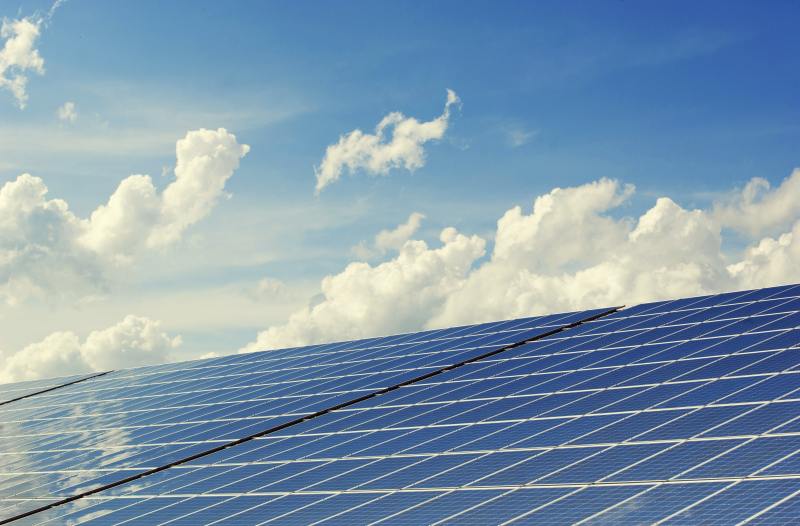On Monday, Stanford announced that its main campus is projected to operate on 100 percent solar power by 2021, when an 88-megawatt photovoltaic plant near Lemoore, California is planned to go online.
Upon completion, the solar plant will push the University past its goal of reducing greenhouse gas emissions by 80 percent by 2025, set out as part of Stanford’s long-range planning process.
After Monday’s announcement, Stanford is also projected to become carbon-free by 2030. California policy calls for a statewide carbon-free grid by 2045.
“Reducing Stanford’s own environmental impact is an essential first step,” wrote University President Marc Tessier-Lavigne in a Notes from the Quad post on Monday. “But cost-effective decarbonization, affordable access to energy and infrastructure resilience are complex global challenges. That is why our long-range vision established an initiative to accelerate sustainable solutions for our region, nation and world.”
Stanford facilities outside California are excluded from the 100 percent solar projection, as are facilities not run by the main campus energy administration. For instance, while the Redwood City campus is set to operate on 100 percent solar power by 2021, the Stanford in Washington house and other Bing Overseas Studies Program facilities are not.
“We don’t have management control, knowledge or responsibility for [some] outlying accounts … and they’re pretty minimal in total [energy use] as well,” said Joseph Stagner, executive director of the Department of Sustainability and Energy Management.
Stagner added that, while Stanford has considered a range of clean energy options — including wind, geothermal and biomass — the University settled on solar because of its relatively low cost and long-term reliability.
“[Solar] is a very stable technology,” Stagner said. “Even with wind, there could be a little worry about whether winds will persist in particular locations over great periods of time with climate change … but you can’t go wrong with the fact that the sun is probably still shining.”
The University has partnered with solar project developer Recurrent Energy to develop the plant, which will be known as Stanford Solar Generating Station #2. Its predecessor, the 67-megawatt Stanford Solar Generating Station #1, went online in 2016 in Rosamond, California. Since 2017, the University has also operated five megawatts of on-campus rooftop photovoltaic panels.
Stanford’s two solar plants will power the University indirectly; the electricity produced by each plant will enter the California state grid at different locations, while Stanford will draw an equivalent amount of electricity from another location on the grid.
“It’s like pouring two different cups of water into a pot and using a different cup to take water out of the pot,” Stagner said.
In the case that an excess amount of electricity is produced by the University’s plants, the extra electricity produced will still be sold but will not result in a profit for the University. Although Station #2 will produce electricity at a lower cost than Station #1, Stagner said that the decreasing market price for power during hours of solar generation will offset potential gains of the new plant to the point that Stanford’s solar power will be “cost-neutral or slightly cost-negative.” But, he added, this is a price the University is willing to pay for clean energy.
According to Stagner, Stanford is contracted to buy all power output from Station #1 and Station #2 until 2041 and 2045, respectively, but the University may renew these contracts and potentially update the plants. Stagner cited a broader debate over whether to focus on solar energy storage or investment in other clean energy sources as one reason for the University’s uncertainty.
“We may or may not decide at some future point to add energy storage to either [of the plants] or both,” he said. “We’re waiting to determine how a carbon-free grid in California evolves.”
“We’re committed to — as grid design unfolds — doing whatever is right ethically and economically and regulatorily to use 100 percent solar assets to displace all of the carbon from the electricity we consume, even if [consumption and production] don’t match on a real time basis,” he added.
While all main campus facilities are projected to be wholly solar powered by 2021, many vehicles in the University’s fleet will still depend on fossil fuels; about 40 percent of the fleet is currently electric, according to Stagner. He noted that, until manufacturers design electric versions of vehicles for which there are currently no such alternatives, the fleet will not be fully electrified. He added, however, that once alternatives are made available, schedules will be developed for swapping vehicles out at the end of their lifespans.
In addition to electrifying its vehicle fleet and substituting its remaining natural gas heating systems with water-based alternatives, the University has convened a Sustainability Design Team, a product of the long-range planning process, to identify and act on other issues related to decreasing Stanford’s carbon consumption.
“The Sustainability Design Team has only recently started to meet and is in the process of developing specific plans going forward,” wrote Stanford spokesperson E.J. Miranda in an email to The Daily.
Despite its efforts at increasing campus sustainability, the University has faced criticism in recent years over its Board of Trustees’ 2016 decision not to divest entirely from the fossil fuel industry. The Board did not accept requests for divestment during the 2017-18 academic year, as a review of Stanford’s Statement on Investment Responsibility is ongoing. Findings of the review may impact the Board’s stance on fossil fuel divestment.
“The trustees are nearing completion of their review of Stanford’s Statement on Investment Responsibility and the University’s related procedures for addressing investment responsibility issues,” Miranda wrote.
Contact Holden Foreman at hs4man21 ‘at’ stanford.edu.
